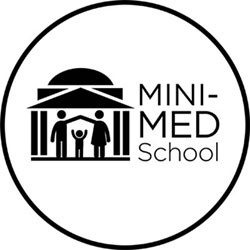Community Engagement
The School of Medicine is a vital part of the West Baltimore neighborhood in which it resides, and we strive to bring a better quality of life to our neighbors. Each year, faculty staff and students log hundreds of hours doing community outreach in hospitals, clinics, homeless shelters and schools throughout Maryland.
Community Engagement Highlights
Mini-Med School
More than 400 Baltimore area residents annually attend Mini-Med School, a series of tuition-free classes designed to help Baltimore residents improve their health and well-being. Presented by faculty physicians, Mini-Med School lectures are designed to be casual, fun, and informative, while focusing on health care issues that are important to everyone.
In addition to providing an important public service, Mini-Med School also helps to raise the public's awareness of biomedical research and the importance of enrolling in clinical trials. One of our Mini-Med School students, who first participated as a college sophomore, was so inspired by the experience that he became an actual medical student at the University of Maryland School of Medicine, and is today a doctor.
The School of Medicine has also held Mini-Med School programs on the Eastern Shore, in western and southern Maryland, and at Baltimore area high schools. Learn More.
The Maryland Area Health Education Center
The Maryland Area Health Education Center (MAHEC) Program exists to address the distribution, diversity, and quality of health professionals serving Maryland’s rural and urban underserved communities. The MAHEC Program and its first center, Maryland Area Health Education Center West or AHEC West (formerly Western Maryland AHEC) were established in 1976. The MAHEC Program has three Centers, AHEC West, Eastern Shore AHEC, and Baltimore AHEC that serve over 70% of the counties in Maryland, including Baltimore City. The Mission of the MAHEC Program is to improve the health status of Marylanders through community educational partnerships that foster a commitment to enhancing healthcare access in the rural and urban underserved areas of the state. The Maryland AHEC Program is a community engagement and impact initiative supported by the University of Maryland School of Medicine with funding from the U.S. Department of Health and Human Services, Health Resources and Services Administration (HRSA) and the Maryland Department of Health and Mental Hygiene (DHMH).
Health Enterprise Zones
State lawmakers have approved a pilot program to reduce health disparities in Maryland through the creation of special Health Enterprise Zones to be supported by the University of Maryland School of Medicine and other health providers throughout the state. The concept was developed by a work group chaired by Dean, E. Albert Reece, M.D., Ph.D., M.B.A. The work group of the Maryland Health Quality and Cost Council recommended tax breaks and other incentives to local health departments and community groups working in underserved areas. The work group found that African Americans in Maryland are nearly twice as likely to be hospitalized for asthma, hypertension and heart failure. Such disparities in the state cost Medicare and extra $26 million annually.
Public Awareness
It is important for legislative leaders and the public to understand the vital need for state and federal funding to support biomedical research and patient care. Such support makes possible innovation and discovery, leads to new treatments and cures and drives economic development throughout the region. We are providing important information to state and national leaders through events such as Transforming Medicine Day and Project Medical Education.
Targeting HIV
The School of Medicine's Institute of Human Virology hosts an annual campus-wide initiative aimed at addressing the HIV crisis. The University of Maryland Leadership in HIV Summit: Preparing the Future brings together faculty and students from all six of the University’s professional schools. The summit includes student displays reflecting how being better informed about HIV has impacted their lives, a campus-wide plenary, breakout sessions and a community partnership town hall that is open to the public. Summit goals include strategies for reducing new HIV infections, increasing access to care and improving health outcomes for people living with HIV, reducing HIV-related health disparities and inequities and achieving a more coordinated response to the national HIV epidemic.
SCHOOL OF MEDICINE STUDENTS HELP THOSE IN NEED
Community Service remains a cornerstone of the student experience at the School of Medicine. Community outreach events include Project Feast and the Student Sight Savers Project, which offers glaucoma screenings at Lexington Market in Baltimore. The Student National Medical Association (SNMA) is especially active in the community, with members providing health education and screening, collecting coats and blankets for the homeless, and providing school supplies and Christmas gifts for children in need. In recognition of their outreach efforts, the SNMA was named national chapter of the year in 2011.
Project Feast
University of Maryland medical student Amanda Wong takes Anthony Clark's blood pressure during Project Feast
For more than 20 consecutive years, our medical students have organized Project Feast to feed hundreds of Baltimore's homeless and needy families on Thanksgiving Day. Students, faculty, staff, and friends gather at Booker T. Washington Middle School in Baltimore City to help prepare and serve a hot Thanksgiving meals, accept donations to help the needy and provide health screening.
Students Support Healthcare for the Homeless
Second year students host an annual auction, with proceeds donated to Healthcare for the Homeless – a University of Maryland affiliated charity that works to reduce the incidence and burden of homelessness in Baltimore by providing health care services, housing assistance, and education to underserved members of the community. The event was organized run by students in their second year of medical school, which also provided entertainment by performing live. Auction items donated by family, friends, faculty and local businesses included gift certificates to local restaurants, spas, and salons, and tickets to sporting events, the symphony, and museums.

